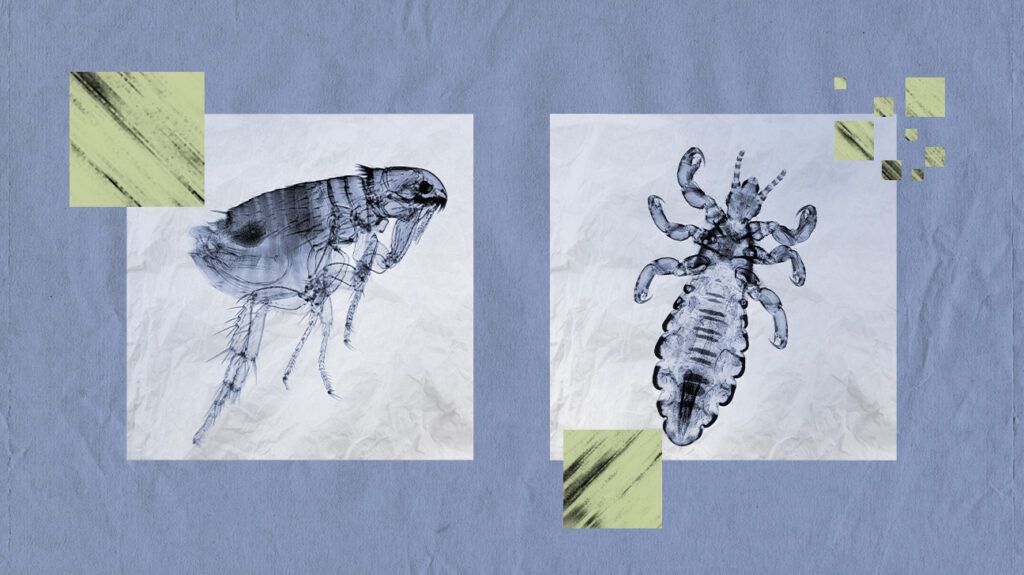Fleas and lice are different parasitic insects that can cause an itchy reaction on the skin. Though similar, they possess unique traits. For example, fleas can jump, but lice can only crawl.
Fleas are wingless parasitic insects that consume the blood of a host animal, including humans. They move from one host to another through jumping.
Head lice are another form of parasitic insect that feed on human blood. They also do not have wings and cannot fly. Instead, they move from host to host through crawling. Some people refer to them simply as “lice.”
This article reviews the similarities and differences between lice and fleas, including their symptoms, causes, treatment, and prevention. It also gives answers to some common questions about the parasitic insects.

The following sections provide information on the symptoms associated with fleas and head lice.
Fleas
Fleas typically cause itching in the area where they bite into a person’s skin. They may also cause inflammation and the appearance of a rash.
In
- bubonic plague
- typhus
- protozoan infestations
- rickettsial disease (commonly from ectoparasites)
- helminth infestations
If a person develops a disease from a flea bite, they may also experience symptoms associated with the underlying medical condition.
Learn about protozoan, ectoparasite, and helminth parasites that can affect humans.
Head lice
According to the Centers for Disease Control and Prevention (CDC), head lice do not transmit disease.
In some cases, head lice may not cause any symptoms. Asymptomatic infestations often occur in light or first-time infestations.
It can take
- itchiness on the scalp, which is the most common symptom
- sensation of something moving in the hair or a tickling sensation
- sores on the head as a result of scratching
- sleeplessness
- irritability
Learn more about parasitic infection in humans.
The following sections provide information on the causes of fleas and head lice.
Fleas
In the United States and other higher income countries, dogs and cats are
Risk factors for coming in contact with fleas
- living with pets that go outdoors
- being in close proximity to wild animals
- difficulty
cleaning the home regularly, particularly if someone has pets
Head lice
Unlike fleas, lice cannot jump. They also cannot fly. Head lice transmit between people through close personal contact.
Lice
- direct head-to-head contact
- sharing personal items, such as hats or other objects placed on the head
- contact with other objects, such as pillows or bedsheets, which may harbor lice
Each year,
The following sections describe treatments for fleas and head lice.
Fleas
Treatment for fleas often addresses symptoms. A person
Treatment for symptoms
- Topical medications: For example, lotions or creams may help with the swelling and itchiness of flea bites. Creams may contain ingredients such as:
- Oral medications: A doctor may recommend a person takes oral antihistamines, such as loratadine or cetirizine, to help ease itchiness. For severe swelling, a doctor may prescribe corticosteroids.
- Home remedies: A person may find relief from itching and inflammation with home remedies, such as by applying a cold compress to the affected area.
Learn more about how to get rid of fleas.
Head lice
Head lice treatment
Current treatments do not reliably destroy lice eggs, so a person will typically require more than one treatment application, with
Common medications for head lice include:
- permethrin
- spinosad
- malathion
- pyrethrins combined with piperonyl butoxide
- benzyl alcohol
- ivermectin
Read more about pediculicides and how they treat head lice.
The following sections provide tips on helping to prevent contracting fleas and head lice.
Fleas
Fleas prefer humid, warm areas. They
According to the CDC, ways to help prevent fleas at home
- keeping the grass cut
- avoiding overwatering of the garden or lawn
- raking up leaves or other debris
keeping pets groomed and washing them regularly- vacuuming or sweeping the house
regularly - cleaning bedding regularly with soap and water
- avoiding contact with wild animals or strays
wearing long sleeves outside - using insect repellents
Head lice
A person can take similar steps to help prevent head lice. Some prevention methods
- regularly cleaning the house, including vacuuming rugs
- discouraging children from engaging in direct head-to-head contact
- not sharing personal items, such as hats or brushes
- machine washing and drying clothes and linens that a person with head lice has used in the 2 days before lice treatment
- avoiding contact with beds, couches, or other surfaces a person with head lice has recently used
According to the CDC, a person does not need to spray or fumigate the home. It does not effectively kill or prevent head lice and can have harmful effects on a person’s health.
Learn more about how lice spread.
Below are some common questions and answers about head lice and fleas.
Can humans get fleas?
Humans can get fleas, but dogs and cats are
Can fleas live in human hair?
Fleas
Can lice jump?
Lice
Head lice and fleas both cause itchy skin reactions in people who encounter them. Fleas may transmit disease to humans, but lice do not.
A person can treat both with medications to help manage symptoms of bites from the insects. People can also use medical treatments to kill lice. People with pets may need to treat them with medications from a veterinarian to kill fleas. Additionally, a person may need to thoroughly clean their home to remove fleas.
People can take steps to avoid both insects, for example, by regularly cleaning the home, limiting contact with stray animals, and washing clothes and linens regularly.
